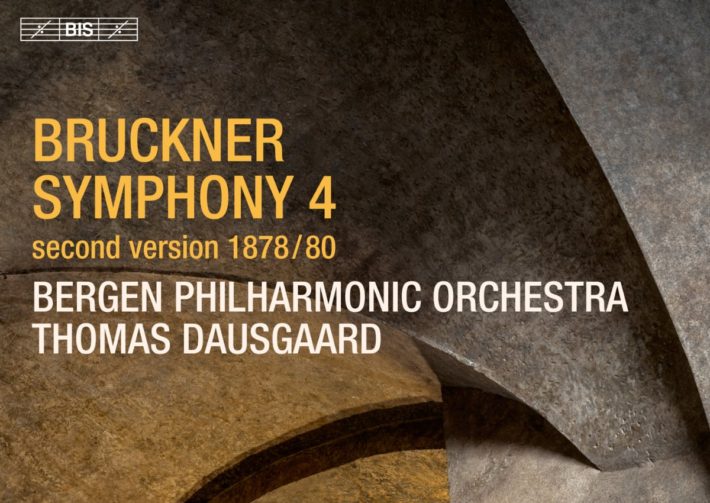This is Dausgaard’s fourth Bruckner recording, three of which feature the Bergen Philharmonic, in what now appears to be a slowly evolving cycle (perhaps to be finished in time for next year’s big Bruckner anniversary). Dausgaard conducts the 1886 Nowak edition, so comparisons are limited to performances of the same edition. This rules our albums by two of the best-known Brucknerians, Karajan and Wand, both of whom conducted the Haas edition exclusively.
Anyone familiar with the previous releases knows what to expect. Dausgaard does not create spacious, lofty spiritual cathedrals of sound. He is instead lean and vigorous, with incisive articulation and wide dynamic contrasts (helped by BIS’ detailed SACD recording). His attention to the wind writing is reminiscent of Klemperer’s approach. Rubato is used sparingly, and phrasing is not micromanaged (as one might expect from a Nelsons performance).
Perhaps the most obvious difference with Dausgaard is his faster than normal tempos, and that is certainly true here: for comparisons I listened to recordings conducted by Zweden (Netherlands Philharmonic/71’35”), Rattle (Berlin Philharmonic/71’19”), Böhm (Vienna Philharmonic/68’10”), Honeck (Pittsburgh Symphony/66’04”), and Jochum (Staatskapelle Dresden/65’03”). Dausgaard brings the symphony in at a little over 60 minutes.
This makes the first minute of the opening movement less mysterious, more bracing. The tempo marking is Allegro in cut time, and Dausgaard conducts it that way, whereas Zweden and Rattle are surely conducting in four (which somewhat negates Bruckner’s indication). There is plenty of drive, yet it never felt rushed, and after several hearings I was convinced of a sweeping vision that makes some of the slower performances feel more episodic. The Bergen Philharmonic is an exceptionally fine orchestra, capable of playing with a hushed intensity one second and blazing brilliance the next, though it lacks the sheer weight of sound we expect from Berlin and Vienna. But there is ample compensation in the quality of their agile and technically brilliant playing.
Related
- Review: Bruckner – Symphony No. 4 – Vienna Philharmonic, Thielemann
- Review: Bruckner – Symphony No. 4 – LSO, Rattle
- Review: Bruckner – Symphonies No. 2 & 8 – Gewandhausorchester Leipzig, Nelsons
The second movement is again quicker than any other performance sampled. And many would argue that Bruckner’s slow movements are the most spiritual and other-worldly. But I suspect Dausgaard believes this music is less about Bruckner’s faith than about his humanity. We do not sense Bruckner praying, but there is a longing, a loneliness in this reading. I initially expected the performance to feel superficial, skimming the surface of the music’s depth. But Dausgaard and his orchestra find a true and deep emotion, less lofty, but more personal and intimate.
The tempo for the Scherzo is more mainstream, the brass reveling in the ending of the Scherzo section. The trio brings a wonderful shift in mood, suggesting a bucolic, lazy summer afternoon in the countryside.
In the final movement, marked ‘Allegro moderato,’ Dausgaard begins at half-note=126, which is indeed right between Moderato and Allegro. It feels fast, but Dausgaard is again conducting the half note as the score indicates. The second subject brings a sense of relaxation, and at 2’40, aided by his characterful woodwinds, Dausgaard finds a folksy, playful character. His avoidance of grand ritardandos at major structural points can be disconcerting: this is the only performance that takes no time before the unison statement of the theme (1’13”). And balances at 2’16” might disappoint: usually dominated by the horns, here everyone is equal, a mosaic of orchestral texture. Throughout, the playing has compelling character and passion.
A different but captivating take on the score that, for the most part, proves convincing. Earlier this year I attended a live performance of the fourth played by the Philadelphia Orchestra under Herbert Blomstedt. That was a more monumental interpretation, very much what I expected to hear – slower, carefully molded, highlighting the glorious ripeness of the Philadelphia strings. At first hearing Dausgaard’s reading is astringent, bright and freshly scrubbed. But on repeated hearings I found the interpretation a different prism through which I can appreciate Bruckner’s brilliance more fully. And isn’t that a great reason to hear any new recording?

Bruckner – Symphony No. 4
Bergen Philharmonic Orchestra
Thomas Dausgaard – Conductor
BIS, CD 2534
Recommended Comparisons
Zweden | Böhm | Honeck | Jochum
Read more classical music reviews or visit The Classic Review Amazon store
Follow Us and Comment:
Get our periodic classical music newsletter with our recent reviews, news and beginners guides.
We respect your privacy.









